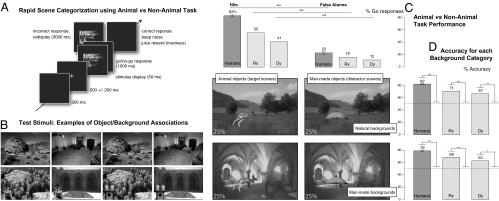Fig. 1.
Animal/Non-Animal categorization performance reached by human and monkey subjects on the first presentation of the test stimuli. (A) Animal/Non-Animal task. Stimuli were presented for three frames unmasked on a black screen. When a scene containing an animal was flashed, subjects had to release a button and touch the tactile screen within 1 s (target stimulus, go response); otherwise, they kept their hands on the button (distractor stimulus, no-go response). Correct (go and no-go) responses were rewarded by a noise (and a juice drop for monkeys); incorrect (go and no-go) responses were punished by the redisplay of the incorrectly categorized stimulus for 3 s. (B) Two examples of the 192 associations of four stimuli. For each association, the man-made and natural backgrounds had equal average luminance and RMS contrast, and the animal and man-made object vignettes had equal surface, center-of-mass location, luminance, and RMS contrast. (C) First-trial hit and false-alarm rates for the group of 11 human subjects and the macaque monkeys Rx and Dy. Bar histograms for hits and false alarms correspond to the stimulus illustrations in the left and right columns, respectively. (Humans: paired t test, t = 26, df = 10, P < 10 × 10−9; Rx: χ2 test, χ2 = 122, P < 10 × 10−9; Dy: χ2 test, χ2 = 86, P < 10 × 10−9.) (D) First-trial performance accuracy (pooling correct go and no-go responses) computed separately for natural and man-made background stimuli. Bar histograms for the accuracies on natural and man-made backgrounds correspond to the stimulus illustrations in the upper and lower rows, respectively. Dotted line represents chance level; error bars indicate SEM. (χ2 tests, natural background—humans: contingency table, χ2 = 269, n = 11, P < 10 × 10−5; Rx: χ2 = 13, P < 0.0003; Dy: χ2 = 9, P < 0.003. χ2 tests, man-made background—humans: contingency table, χ2 = 327, n = 11, P < 10 × 10−5; Rx: χ2 = 11, P < 0.001; Dy: χ2 = 6, P < 0.02.)

